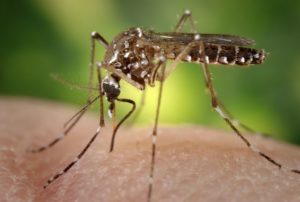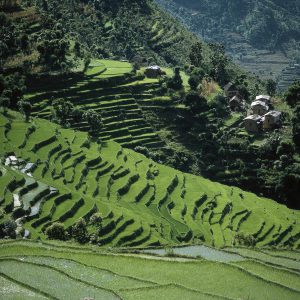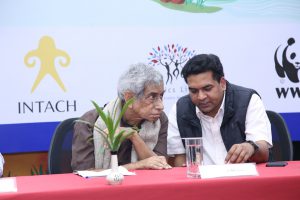After the intense floods of November-December 2015, Chennai developed a network of informal sources on weather-related reporting. R. Pradeep John, an amateur weather watcher who calls himself the Tamil Nadu Weatherman, emerged as an important source of informal information for many Chennai citizens. With access to radar data on the weather, John interpreted the numbers in a timely fashion through the social media.
John had been writing about Cyclone Vardah for a few days before landfall. But on the afternoon of December 12, just as the cyclone was making landfall, he sounded scared. “I have never seen anything like (this) in my life,” he posted. “This is worse than 1994, absolute carnage here… Stay safe at home. Chennai is not used to this type of high winds. Please take this as serious advice.”
His words were ominous. For the next few hours, Chennai and adjoining districts were battered by strong winds and heavy rain as Cyclone Vardah crossed over from the Bay of Bengal to peninsular India. It had changed its track slightly. While it was expected to cross south of Chennai city, it crossed to the north, over the Pulicat Lake. According to the wind tracking website Windfinder, the average wind speeds recorded at Chennai Airport during landfall was 55 knots (101.86 kms per hour) and the gust speed was 75 knots (138.9 kmph).
Cyclone Vardah was termed a very severe cyclone. There was rain and strong winds in one direction as the forward eye wall crossed the city. Then there was a pause, as the eye of the cyclone passed overhead, followed by more rain and wind in the opposite direction, which continued late into the evening. After it passed, the city was like a battleground.
Correct prognosis
The severity of Cyclone Vardah seems to have proved correct the prognosis of the Tamil Nadu State Action Plan for Climate Change. The document, released in July 2014, had stated: “In future, the number of cyclones hitting the eastern Indian coast including Tamil Nadu is likely to reduce, however, the intensity, i.e., the wind speed of the cyclones may increase.” What the action plan did not foresee was that these events would require innovative action to strengthen the climate resilience of the city.
Located on the Bay of Bengal coast, Chennai is prone to cyclonic rains and flooding. However, the November-December 2015 floods and Cyclone Vardah of 2016 brought to the city events of very high intensity. The question is whether these events are forerunners to similar extreme weather events for the city in the future.
See: Last year’s Chennai deluge not due to climate change
Cyclone Vardah exposed another vulnerability that Chennai had not taken into account before – high velocity winds. Being a flat city next to the coast, Chennai is vulnerable to flooding and waterlogging. The city also comes under earthquake zone 3, and is vulnerable to moderate risk of earthquakes. Some parts of the city even go into zone 4.
Potable water problem
Compounding these vulnerabilities is the fact that the city does not have access to enough sources of water supply, and depends on a combination of groundwater, surface water from long distances and seawater desalinisation. Any event that disrupts this supply over a long period can put the residents of the city in a dangerous situation.
This happened both during the 2015 floods and the 2016 cyclone. The disruption in water supply was due to the disruption of power supply, which had to be kept switched off till local-level connectivity issues were sorted out. Even as this is written, some parts of the city have not got regular power supply, as the Chennai Corporation and the Tamil Nadu Electricity Board are struggling to remove fallen trees and set right transformers and connections. The situation was similar during and after the December 2015 floods where some parts of the city took more than five days to get power connectivity.
The 2015 and the 2016 events exposed the lacuna of credible ground level, usable, disaggregated information. During the 2015 floods, people outside Chennai had more information about the flood, its cause and the enormity of the damage that it had caused, than those who were in the city and living through the impact of the rising waters.
The weather bulletins from the India Meteorological Department (IMD) covered the week as a block, and were of no use to someone wanting to know what the next bout of rain would bring. Weather information website Skymet Weather published hourly Insat satellite images, which gave an idea of the cloud mass over the city.
In addition to the television statements by S.R. Ramanana, director of IMD’s Cyclone Warning Centre, there were informal weather experts giving out information. These two bridged the gap between the macro and the micro picture.
Connectivity issues
There was a catch though. People in flooded Chennai had no power or connectivity to access any of this information. In fact, when the sluice gates of the Chembarambakkam Lake upstream of the city on the Adayar River were opened on December 1, 2015, the residents living on the banks of the river were taken by surprise by the rising waters in their homes. For nearly a week, the residents did not know what was happening in their city beyond what was before their eyes. This is where road-to-road public announcements or local-level meetings could have helped.
Unlike the floods that lasted for days, Cyclone Vardah lasted only for hours. However, even then there was a shortage of adequate, usable information. For instance, this cyclone was different from the milder ones that have visited the city earlier – the wind impact was stronger than the rain impact. Having faced the brunt of last year’s floods, many residents moved their vehicles to higher, drier ground this year. Falling trees smashed many of these cars and two-wheelers.
Weak roots
Chennai is a relatively green city, with many trees in apartment compounds and roadsides. In recent years, the Chennai Corporation and private gardeners have preferred planting ornamental trees such as the rain tree (Albizia saman) and the gulmohar (Delonix regia) for their ability to grow fast and provide shade. These trees do not have the deep-rooted stability of the native species such as mango and neem, and could not withstand the gale speed winds. More than 10,000 trees were uprooted during Cyclone Vardah and destroyed electric lines, buildings and vehicles.
![More than 10,000 trees were uprooted [image by S Gopikrishna Warrier]](/wp-content/uploads/2016/12/Cyclone2.jpeg)
As the events of past two years have shown for Chennai, weather events of increasing intensity can become the new normal in the future. Cyclones and floods are not the only dangers for the city on the coast. Sea level rise, rising storm surges and ingress of saline water are the other climate-related risks for Chennai. The lesson that these events have taught are that new understanding and improved responses are required to keep one step ahead of each event and thereby strengthen the city’s resilience.
![<p>Cyclone Vardah saw terrifying wind speeds, with lots of trees falling over [image by S Gopikrishna Warrier]</p>](https://dialogue.earth/content/uploads/2016/12/Cyclone1-300x200.jpeg)






![Biomass burning is a major source of air pollution. [photo by Ahron-de Leeuw]](https://dialogue.earth/content/uploads/2016/12/Varanasi-ghat-Ahron-de-Leeuw-300x199.jpg)
